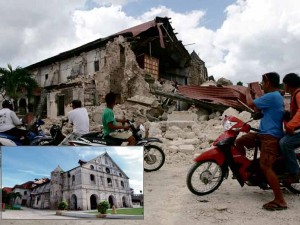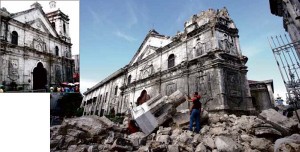The challenging task of rebuilding heritage

LOBOC Church in Bohol before (inset) and after a 7.2-magnitude earthquake hit the province. Photo by MARIANNE BERMUDEZ and NHCP
For a stone church to rise during the Spanish era, construction took from several years to many decades to be completed, depending on the availability of funds, construction materials and laborers.
For instance, work on Basilica del Santo Niño in Cebu City began in 1730, but it took a decade to finish it. The image of the Holy Child, a gift of Portuguese explorer Ferdinand Magellan to Queen Juana of Cebu province in 1521, was then enthroned.
Bugged by the frequent shortage of funds, the church project was only completed with the help of the parishes of Opon and San Nicolas towns, whose residents contributed coral stones. Those from Talisay town contributed manpower.
The parish church of Our Lady of the Assumption in Dauis town, Bohol province, was erected in 1863 by Fr. Jose Saldana, but it was completed in 1923 because of the many difficulties faced by the builders. Bishop Juan Gorordo of Cebu came to consecrate it.
Work on Cebu Metropolitan Cathedral, the seat of what was then the biggest diocese in the Philippines, began in 1866 but was left unfinished before the expulsion of the Spaniards in 1898.
Community work
Church construction in the past was literally a community activity. It was not the responsibility only of the parish priest but of the people as well.
On Tuesday, a 7.2-magnitude earthquake destroyed or damaged several heritage churches in Bohol province. Four collapsed in Inabanga, Loon, Loboc and Maribojoc towns, while 20 others were disfigured, according to the provincial police.
The government’s culture agency dispatched experts to Bohol to assess the extent of damage, as well as identify properties that need to be secured and draw a list of priorities for potential restoration.

BASILICA del Santo Niño in Cebu City before (above) and after the earthquake. Photo from Basilicasantonino.org.ph and by JUNJIE MENDOZA/CDN
Parishioners and church-heritage workers alike are in a quandary if it is still possible to rebuild fallen churches or restore some of its damaged parts.
As national cultural treasures, a declaration that could allow the use of government funds, some churches may be reconstructed or restored, according to the National Commission for Culture and the Arts (NCCA).
While rebuilding a church using original materials is possible and may cost millions or even billions of pesos, it can also be hampered by nonavailability of materials.
Stone churches in Central Visayas are made of coral stones mined from the sea. As most church construction activities were made during the Spanish era, coral stones may not be readily available today.
Lumber, which was used for trusses, floors, pews and retablos, is another problem. In the past, an entire forest had to be cut down to build a single church.
Having all materials doesn’t make a church stand.
The coral stones had to be hewn into blocks. As instructed by the “maestrillo de la obra” (master carpenter), the cut stones, known as “tablilla,” were put in place using “argamasa”—a mixture of lime, sand and egg whites.
The lumber used, usually of “balayong” or “tugas,” had to be sawn off manually and put into place with wooden pegs.
Bishop Lito Cortes, Catholic Bishops’ Conference of the Philippines chair on church heritage and incoming prelate of Dumaguete City in Negros Oriental province, said a composite team from the NCCA, National Museum and the National Historical Commission of the Philippines was in Bohol to assess the damage brought by the temblor.
But the team couldn’t come up with a complete assessment as yet due to intermittent aftershocks.
Basilica del Santo Niño, whose belfry fell, already has a team from Escuela Taller, a conservation firm based in Intramuros, Manila, to check on the extent of damage, according to Cortes.
The belfry may be restored to its original, but it would have to tap modern technology to strengthen it.
An architect involved in heritage work, who refused to be named, said that for any of the fallen churches to rise again, adaptive reuse of the original materials might be recommended. If certain parts of the church are still intact and structurally sound, it can still be used.
A portion of a collapsed wall, for instance, may be filled with core pilings to strengthen it and the damaged portions may be filled with reinforced concrete.
Cladding
Churches reduced to rubble, like those in Maribojoc and Loon towns, pose a greater problem. Rebuilding to their original form is close to impossible, the architect said.
The best way is to use reinforced concrete and utilize the wreck’s coral stone blocks for cladding.
He estimated that the structure alone could cost about P15,000 per square meter. If it includes cladding or low-relief sculptures like those found in facades, it could mean another P15,000 or more.
The NCCA leaves it to the people of the communities to decide what to do—restore their church or build a new one.